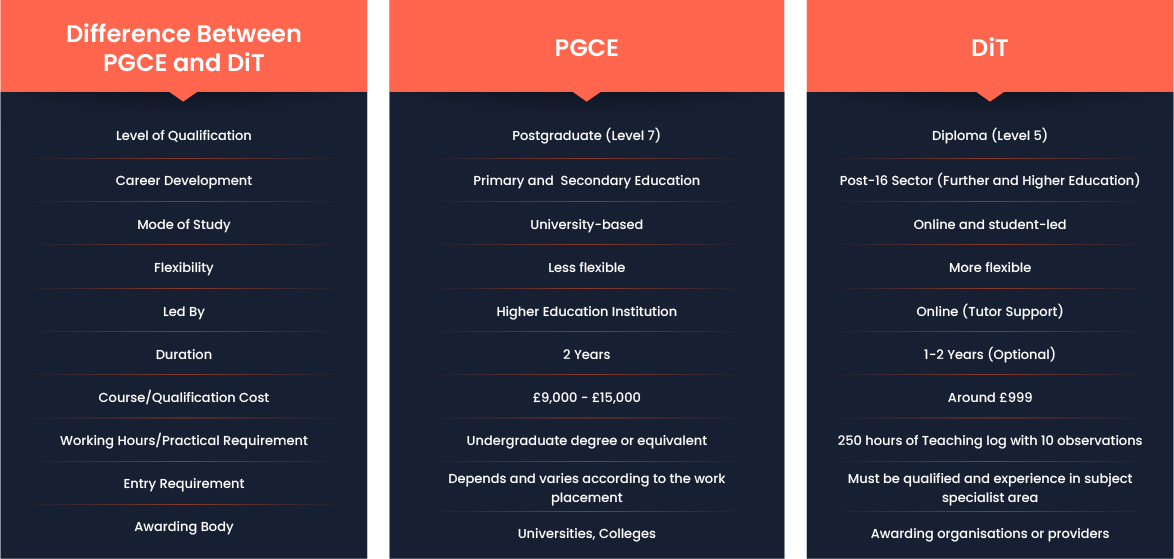PGCE (Postgraduate Certificate in Education) and DiT – Diploma in Teaching (FE and skills) are both initial teacher/training educational qualifications. One helps you become a qualified teacher and provides you with basic teacher training, whereas a Diploma in education and training makes you qualified to achieve QTLS status in England.
Key Takeaways:
- PGCE is for teaching in schools, while DiT qualifies you for further education and lifelong learning.
- PGCE takes 1-2 years with mandatory school placements, whereas DiT can be completed online at your own pace with 250 hours of placement.
- PGCE requires a degree, DiT does not – PGCE demands a relevant degree, while DiT only requires an RQF qualification in your subject.
Both PGCE and DiT share some similarities but it can be hard to define and understand the difference between the two in terms of their course content, duration and how much it costs to study both qualifications. In this blog, we aim to clarify these differences and similarities and provide you with complete information.

Postgraduate Certificate in Education (PGCE)
There are many routes to becoming a teacher, but the Post Graduate Certification in Education (PGCE) is the most common one. It is a postgraduate qualification if you wish to pursue a teaching/training career in the primary and secondary sectors.
Postgraduate Certificate in Education leads you to achieve QTS (Qualified Teacher Status) which legal requirement to teach in the UK. With this being said, you may ask ‘Do I necessarily need PGCE to teach in England’? The simple answer is, it’s up to you. If you want to kick start your career in the best way possible, you can go for PGCE; otherwise, if you have a relevant degree, you can choose other routes to gain QTS.
However, if you choose to achieve a Postgraduate Certificate in Education, it can take around 1-2 years to complete. In the first year of the study, after completing some assignments and lectures you will be awarded as a Newly Qualified Teacher. Additionally, once you have completed the theoretical part, the remaining second year, you must look for school placements, and teach students and you will be assessed accordingly by your university lecturers and teaching mentors. You will be eligible for Qualified Teaching Status (QTS).
Diploma in Teaching (FE and Skills) DiT
Level 5 Diploma in Education and Training (DTLLS) is an undergraduate qualification for those who already work as a teacher and wish to polish their skills to teach in the adult education sector – Further Education (FE) or Higher Education (HE).
This qualification enables you to apply for QTLS (Qualified Teacher Learning and Skills status), which is awarded by the Society for Education and Training (SET). Gaining QTLS demonstrates that you meet the national professional standards for teaching in the Further Education and Skills sector, enhancing your credibility, employability, and progression opportunities within post-14 and post-16 education settings.
It can be easily completed online with one-to-one tutor support. It is completely self-paced, which allows you to complete it in either 6 months or a maximum of two years. On top of that, you don’t need to require a previous degree, all you need is a relevant RQF qualification in your field and you can achieve DiT easily. As DiT is equivalent to PGCE FE and PGCE HE, it is perfect for those who want to teach students aged 14 years old.
What Makes These Qualifications Different From Each Other?
Though both are teacher training qualifications, they have their own course completion time, course cost and entry requirements. Here are some of the prominent differences between PGCE and DET:

While one leads to QTS, the other leads to QTLS; both are equivalent in the life-long learning sector. With this being said, we have mentioned a few aspects in which PGCE and DiT are somewhat similar. Here is how:
Similarities between PGCE and DiT
Essential Teaching Skills and Knowledge
- The course content included in both the Postgraduate Certificate in Education and Diploma in Teaching (FE and skills) share some similar themes in their modules.
- Both the qualifications include learning and teaching theories, and reading and research theories.
- All learners will have a proper command of essential skills like classroom management, lesson planning or assessment. They can efficiently know how to devise and deliver lesson plans; how best people learn or whether the course content complies with the specific subject requirements or not.
- Once enrolled, students will be equipped with in-depth knowledge of skills like curriculum development etc in their relevant sector.
Practical Requirements
- PGCE and DiT are both an amalgamation of theoretical knowledge and teaching practice; therefore, once students are done with the theoretical part they must demonstrate their competence and put theory into practice.
Specialisation or Study Area
- Whether one chooses to enrol on a Postgraduate Certificate in Education or Diploma in Teaching (FE and skills), they can choose from a variety of topics based on their interests and aspirations.

What Should I Choose: PGCE or DiT?
As the most recognised qualifications in the UK, many students each year enrol on either of the qualifications. PGCE, a postgraduate degree, demands higher expectations, undivided attention and commitment. However, students find this path challenging and DiT much easier because you can achieve DiT from the comfort of your home.
So, if you cannot meet short deadlines or lack academic writing and research skills, PGCE might be an inappropriate path for you. Instead, you can choose to enrol on DiT and complete it at your desired pace.
Conclusion
Postgraduate Certificate in Education and Diploma in Education both have become increasingly popular among learners who wish to become teachers as these qualifications are considered equal in the lifelong sector. Though there are many routes to becoming a qualified teacher, the most popular are DiT and PGCE.
Those who choose PGCE, after 1-2 years of training induction in a school, they can become fully accredited qualified teachers and gain QTS. On the other hand, learners who choose DiT, a slightly shorter, faster and cheaper route, can earn their QTLS via a governing body and do not even require a 1-year training induction in a learning environment.




